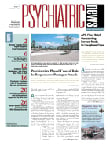Psychiatric care for people affected by the September 11 attacks on New York's World Trade Center has happened on large and small scales.
At one end of the spectrum, New Jersey child psychiatrist Margaret Tompsett, M.D., teamed up with an art therapist to care for a group of 10 children who lost their fathers on September 11.
The art therapist, Donna Dandrilli, M.A., had already met with a group of widows who were still trying to cope with the loss of their husbands in the attack. In the midst of their own distress, the women also understood that their children had even more difficulty grasping the loss of their fathers.
The children were frequently worried, angry, defiant, or weeping. Several had trouble sleeping or eating.
Tomsett and Dandrilli wanted to help the children better understand the concept of death and to help them begin processing the traumatic memories and find constructive ways of coping, Tompsett told Psychiatric News.
The two divided the children into younger and older groups. Tompsett took the younger children, aged 5 through 7, while her colleague took the older children.
The older children (two boys and two girls) were able to articulate their memories and feelings about their fathers, often as they worked with clay.
In Tompsett's younger group, the boys had difficulty verbalizing, but the girls were able to talk about their feelings, sometimes blaming themselves for letting their fathers go to work that day. Tompsett helped them understand that they were not at fault for their fathers' deaths.
One unusual aspect of this process was that while only the children were grieving, both the children and their group leaders had been exposed to the same repeated television images of the disaster.
The groups met weekly through Thanksgiving 2001, then again after Christmas and the following year's Valentine's Day. While the children have not been formally followed since, many of the widows continued to meet as a support group, said Tompsett.
Large Program Helps Survivors, Workers
A substantially larger and still ongoing project is the World Trade Center Medical Monitoring Program.
Police officers, firefighters, paramedics, and construction workers who responded to the attacks at the World Trade Center site were exposed not only to the chemical and biological toxins pervading the air and debris but to repeated encounters with the human carnage wrought by the attack.
The combination left physical and psychological scars on many thousands of people across three states.
On Long Island, 6,000 of these responders received surveillance and medical care for respiratory problems, mental health symptoms, and other effects of their time at ground zero through the World Trade Center Medical Monitoring Program.
The program was established in 2002 with a grant from the National Institute for Occupational Safety and Health. The institute made additional grants of $90 million in 2004 and $52 million in 2006.
"Medical and psychiatric conditions are often comorbid and have a synergistic effect on functionality," said Benjamin Luft, M.D., the Edmund D. Pellegrino Professor of Medicine and chief of the Division of Infectious Diseases at Stony Brook University School of Medicine on Long Island.
"The two domains work hand in hand, and you have to break that cycle to successfully treat patients," said Luft, who directs the monitoring program's work in the Long Island area.
Program Comprises Three Components
Patients in the program who have psychiatric symptoms are managed using a three-component model, much like the MacArthur model for depression care, said Steven Cole, M.D., a professor of psychiatry at Stony Brook and director of the psychiatric part of the monitoring program.
Those components are a primary care physician (usually an occupational medicine specialist), a consulting psychiatrist, and a care manager who communicates with the two physicians, as well as with the patient.
The program now employs six psychiatrists and seven care managers, said Cole, in an interview.
"We train the doctors to use the PHQ-9 to screen for depression and the PTSD Checklist to screen for PTSD," he said.
The primary care physician uses a stepped-care algorithm to begin treatment, and the care manager sees the patient once a month for follow-up monitoring.
"The psychiatrists meet weekly with the care managers to discuss problem cases," said Cole. "Is the patient getting better? Worse? Then we give feedback to the doctors and case managers."
Stony Brook has seen between 600 and 800 World Trade Center workers in its mental health program. Half of those cases have been very complex, said Cole.
"With many, there is a mix of PTSD and panic disorder," he said. "They really need exposure-based psychotherapy to regain function." But too few people are trained in exposure-based therapy, said Cole. "It's a painful approach, and the therapist has to be very skilled."
Many cases of PTSD have cropped up years later in people who had remained relatively stable for years, until something triggered more pathological symptoms, said Cole. But he has also seen nearly complete recoveries by very impaired people.
Many patients who could benefit from psychotherapy are often initially resistant to it because of stigma, particularly police officers and firefighters, said Luft.
However, such resistance is often overcome with more time spent in the program. Eventually, 80 percent to 85 percent of initially resistant patients remain in care in the program for at least a year, said Luft.
"What we do here is work on their wellness and resiliency—not just getting rid of symptoms, said Luft. "A lot of memories are deeply etched, and it's hard to overcome that. I don't know why memories are more vivid in some people than in others."
Personal accounts of the September 11 attacks on the World Trade Center have been collected by the Stony Brook University medical staff and are posted at <www.911respondersremember.org>. 